Affiliate disclosure: This post may contain affiliate links. Please see our Privacy Policy.
Preserving eggs without refrigeration is a challenge people have faced for centuries. How do you keep the abundance of spring-laid eggs fresh and usable when your hens stop laying in the winter?
Storing eggs in limewater is a time-tested method for preserving fresh, unwashed eggs without refrigeration. This traditional technique uses food-grade pickling lime to seal the eggshells, keeping them fresh for up to a year or more.
Whether you’re raising your own backyard flock or buying from a local farm, it’s one of the most dependable ways to stretch your spring surplus into the winter baking season, no freezer, fridge, or fancy equipment required.
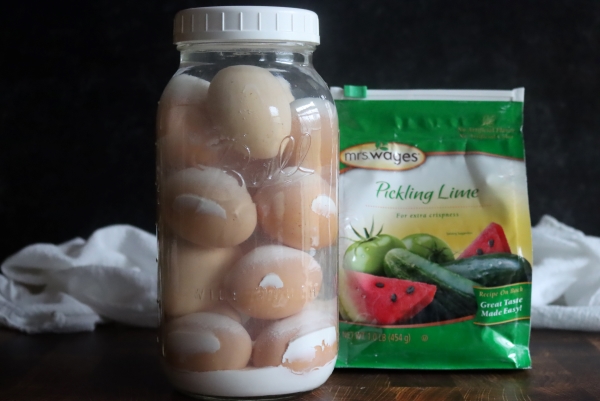
Table of Contents
- Basics of Preserving Eggs
- How Limewater Preservation Works
- Is Limewater the Same as Waterglassing Eggs?
- What You’ll Need
- How to Make Limewater for Egg Storage
- How to Store Eggs in Limewater
- How Long Do Eggs Last in Limewater?
- Does It Change the Taste or Texture?
- Alternative Historical Lime-Based Egg Preservation
- Can I Use Grocery Store Eggs?
- Storing Eggs in Limewater Recipe
- Food Preservation Tutorials
- Frequently Asked Questions
Anyone who keeps chickens knows the struggle: your hens are laying more eggs than you can handle in spring and summer, and then suddenly stop just when the days grow short and you finally feel like baking again. Historically, people had dozens of methods to store eggs for the off-season, but most have drawbacks.
One method stands out for its simplicity, effectiveness, and proven history: storing eggs in a food-safe lime solution made with pickling lime.
I started using limewater preservation because the seasonal rhythm of egg laying never quite matches when I want eggs most. In the spring, I’m buried in eggs but too busy in the garden to bake. By winter, when the days are short and cozy baking season hits, the hens have slowed to a crawl or stopped laying entirely.
We keep our limewater jars on a cool shelf in the basement, right next to the home-canned tomatoes and a crate of root-cellared apples. It’s a satisfying sight in the middle of January—eggs from springtime, still fresh and ready to cook.
Basics of Preserving Eggs
There are literally dozens of ways to preserve eggs.
They stored them in wood ash, wheat bran, and straw, or coated them with butter or lard, or kneaded them into homemade pasta that was hung to dry.
Most of the methods rely on a few simple principles:
- Start with clean, fresh eggs.
- Don’t wash the eggs at all. That removes their natural “bloom” that prevents bacteria from entering through pores in the shell. (Grocery store eggs are washed, and will not keep outside the refrigerator. Do not attempt this, or any other egg preservation technique with grocery store eggs.)
- Keep the eggs cool, but not too cold. An egg is a living thing, and it’ll stay fresh best unwashed and at around 50 degrees (root cellar cool).
- If possible, seal the pores off further to prevent contamination within the egg. Oil, ash, and lime are the most popular choices.
Simply storing fresh, unwashed eggs in a cool environment (around 50 degrees) will buy you a lot of time. We’ve taken our fresh eggs and stored them in the basement dependably for up to 4 months, and occasionally as long as 6 months, no treatment required (so long as they’re not washed).
If you’d like to dependably store eggs for longer than 4 months, like if you’re trying to store an overabundance of spring eggs for the next winter’s baking, you’ll need a bit of help to get them to keep that long.
While many different methods work, most have drawbacks.
Over the years, I’ve experimented with other traditional methods—storing in wood ash gave the eggs a musty flavor, and salt draws out too much moisture. Traditional waterglass (with sodium silicate) worked, but it altered the eggs enough that whites wouldn’t whip and the flavor wasn’t quite right. (Sodium silicate is used for sealing tile these days, so it’s not exactly considered food safe by modern standards either.)
So what does work? Storing eggs in a food-safe lime solution made with pickling lime (calcium hydroxide).
Limewater has been the most reliable method by far, with no off-flavors or texture changes.
By storing eggs in limewater, you can preserve the taste, texture, and function of fresh eggs for 8 to 12 months. Unlike other methods—such as coating in lard, burying in ash, or storing in salt—limewater doesn’t alter the flavor or draw moisture from the eggs. When stored properly, lime-preserved eggs can still fry up, bake, and whip like fresh.

How Limewater Preservation Works
Limewater preservation works by sealing the eggshell’s pores with calcium, preventing air and bacteria from entering and stopping moisture from escaping. The lime used in this process is Food Grade Pickling Lime, also known as calcium hydroxide—a food-grade product that’s often used to firm vegetables during pickling.
Though it’s called “pickling lime,” limewater doesn’t pickle the eggs. The process keeps the eggs in the same state, and once you pull them out of the solution, they can be used just like a fresh egg. They fry up beautifully, and the white still whip to stiff peaks.
It’s called “pickling lime” because it’s used to firm up veggies before pickling, namely Limed Dill Pickles, and old-fashioned watermelon rind pickles. It works the same way to firm up the eggshells and seal them at the same time.
Don’t believe me? Here’s someone cooking with eggs after a full year in lime water:
Is Limewater the Same as Waterglassing Eggs?
These days, many people refer to preserving eggs in limewater as waterglassing, but technically, that’s not quite accurate.
Traditional waterglassing used sodium silicate (often sold as “waterglass”)—a thick, syrupy liquid that was mixed with water to preserve eggs. It was popular in the early 20th century and did an excellent job of preventing spoilage. However, sodium silicate is now more commonly used as a tile sealant or concrete hardener, and it’s no longer considered food-safe for home preservation. Eggs stored in waterglass often developed rubbery whites and wouldn’t whip properly, even if they remained edible.
The method I’m sharing here uses pickling lime (calcium hydroxide), which is still food-safe and easy to find in the canning aisle or online. While it works in a similar way—sealing the eggshell to block air and bacteria—it’s a completely different substance from waterglass.
That said, most people searching online for “how to waterglass eggs” are actually looking for this limewater method. So while it’s not technically waterglassing in the historical sense, this pickling lime method has become the modern go-to for long-term egg storage—and for good reason. It preserves both flavor and texture, and eggs stored this way can still be used for frying, baking, and even whipping.
What You’ll Need
To preserve eggs in limewater, gather the following:
- Fresh, unwashed eggs (laid that day if possible)
- Pickling lime (calcium hydroxide) – food-grade only
- Clean glass jars, ceramic crocks, or food-safe plastic buckets
- Cool storage area (like a basement or root cellar)
Do not use grocery store eggs for this method. Store-bought eggs in the U.S. are washed, which removes the protective bloom and allows bacteria to enter through the porous shell. Only use unwashed eggs from your own flock or a trusted local source.
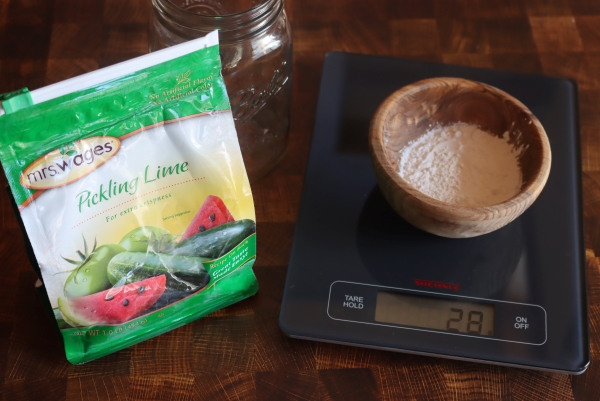
How to Make Limewater for Egg Storage
To make a saturated lime solution:
- Use 1 ounce (28g) of pickling lime per 1 quart (4 cups) of clean, cool water. This is roughly 2 heaping tablespoons of lime powder.
- Mix the lime and water in a jar or bowl. The solution will turn cloudy, and some lime will settle to the bottom—that’s normal and expected.
- This ratio ensures a saturated solution, providing a consistent seal over time without overusing lime.
One quart of solution is typically enough to fill a half-gallon jar once the eggs are added.
Don’t worry if some lime settles at the bottom of the jar—that’s normal. I’ve found that using about one ounce per quart is the sweet spot: enough to create a saturated solution without wasting lime unnecessarily.
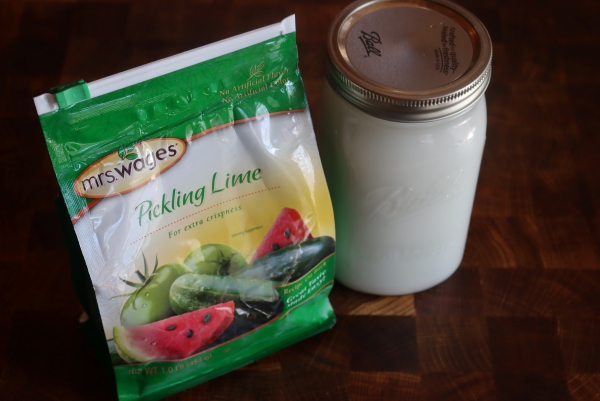
How to Store Eggs in Limewater
- Select only clean, unwashed, fresh eggs. Check for cracks or dirt—any contamination can spoil the whole batch.
- Fill a clean jar or container with eggs, placing them pointy-end down if possible, but orientation doesn’t really matter that much.
- Pour the lime solution over the eggs until they’re completely submerged.
- Cap the jar (or cover with a lid) and store in a cool, dark place—ideally around 50°F.
A half-gallon mason jar will hold roughly 14 to 18 eggs, depending on size. You can also use something like these one-gallon glass jars, which will hold about three dozen eggs.
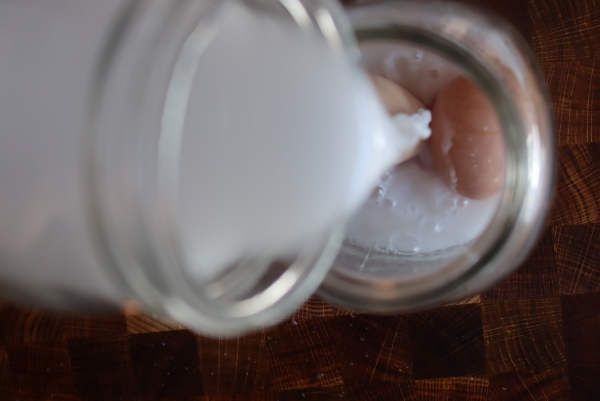
Historically, they would have been stored in wooden barrels or ceramic crocks (like this one that I use to make sauerkraut a gallon at a time).
Alternatively, a food-safe plastic bucket will work if you want to store them in bulk.
We keep our jars of eggs in the basement, right next to my home-canned goods and root-cellared apples.
Once you’re ready to use the eggs, simply remove them from the solution and give them a rinse before cracking. Rinsing ensures that the lime solution doesn’t get into the egg as it’s cracked, which will impact the flavor.
Then, cook with the eggs as you otherwise would.
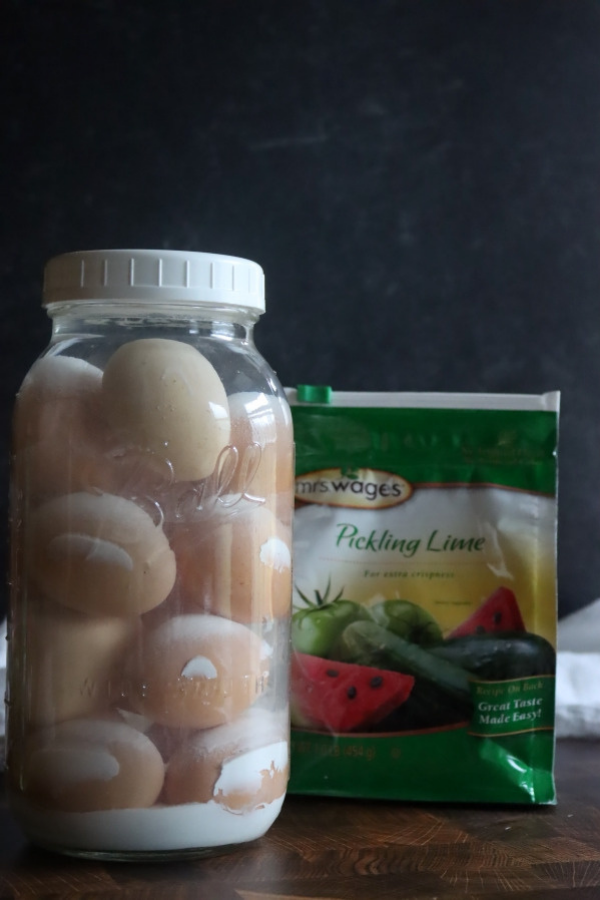
How Long Do Eggs Last in Limewater?
Properly stored, eggs preserved in limewater can last 8 to 12 months or longer. Many homesteaders report success frying, baking, and whipping limewater eggs a full year after preservation. The key is to keep them submerged, cool, and undisturbed.
When you’re ready to use the eggs, rinse each one thoroughly before cracking to avoid introducing lime solution into the egg.
Does It Change the Taste or Texture?
No—when stored correctly, limewater eggs retain their taste and texture remarkably well. They fry like fresh eggs, bake beautifully, and even whip to stiff peaks for meringue and angel food cake. Unlike waterglassed eggs (preserved in sodium silicate), limewater eggs don’t soften or change structurally over time.
Alternative Historical Lime-Based Egg Preservation
I found a reference to preserving eggs in lime water in the book from the 1950s called “Stocking Up.” It contains all manner of historical food preservation information and has a whole chapter on eggs.
It notes that most people “found some way to clog up the pores of the eggshells so that moisture would not escape and air could not enter. Eggs were rubbed with grease, zinc, or boric ointment, or submerged in a solution of lime, salt, cream of tartar, and water.”
While stocking up does not give proportions, I found a reference on a historical food and cookery site that suggest this method:
“To one pint of slacked lime, add one pint of salt, two ounces of cream of tartar, and four gallons of water. Boil all together for ten minutes. Skim, and when cold, pour it over the eggs. Lay a light saucer upon the top to keep them underwater, and keep in a cool place. Renew the lime water every three weeks.”
So for that method, you’d need:
- 1 pint slaked lime
- 1 pint salt
- 2 oz cream of tartar
- 4 gallons of water
The downside of this mixed solution is that the salt permeates the shells and will flavor the eggs, so I’d suggest going with a simple lime solution without salt.
Can I Use Grocery Store Eggs?
Unfortunately, no. U.S. grocery store eggs are washed and sanitized, removing the natural protective bloom on the shell. This makes them unsuitable for room-temperature storage or limewater preservation. Use only unwashed, farm-fresh eggs for this method—ideally from your own chickens or a trusted local farm.
In many other countries, eggs are sold unwashed and unrefrigerated, which makes preservation easier. But in the U.S., safe limewater preservation requires unwashed eggs only.
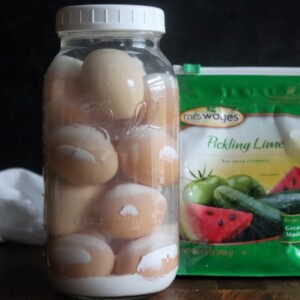
Storing Eggs in Limewater
Equipment
- Half Gallon Mason Jar
Ingredients
- 16 large eggs, fresh, unwashed eggs (collected the same day)
- 1 quart cool water
- 1 ounce food grade pickling lime, 28 g or ~2 heaping tablespoons, calcium hydroxide
Instructions
- In a quart mason jar or mixing bowl, combine 1 quart of cool water with 1 ounce of pickling lime. Stir or shake to create a saturated lime solution—it will appear milky, and some lime will settle to the bottom (that’s normal).
- Gently place 16 clean, unwashed eggs into a clean half-gallon glass jar.
- Pour the limewater solution over the eggs until they’re fully submerged. Cap the jar and store in a cool, dark place.
Notes
Food Preservation Tutorials
Looking for more historical food preservation tutorials?
- Salt-Cured Duck Breast
- Preserving Cheese in Wood Ash
- Salt Cured Egg Yolks
- 18th Century Farmhouse Cheddar
- How to Preserve a Whole Pig Without Refrigeration
Frequently Asked Questions
No. Traditional waterglass refers to sodium silicate, while limewater uses pickling lime (calcium hydroxide). Though both methods preserve eggs by sealing the shell, pickling lime is food-safe and doesn’t affect the flavor or texture of the eggs. Today, most people searching for “waterglassing eggs” are actually referring to the limewater method.
No. Grocery store eggs in the U.S. are washed, which removes the natural protective coating (bloom) and opens the shell’s pores. This makes them unsafe for room-temperature or limewater storage. Only use unwashed, farm-fresh eggs for this method.
Properly stored eggs in limewater can last 8 to 12 months or longer. The key is to keep them cool, fully submerged, and in a clean, sealed container.
No. Eggs stored in limewater retain their original flavor and texture when handled properly. They can be fried, scrambled, baked, or even whipped like fresh eggs.
No refrigeration is needed. Store the jars in a cool, dark place like a basement, pantry, or root cellar. Temperatures around 50°F are ideal.
Glass jars, ceramic crocks, or food-safe plastic buckets all work. A half-gallon jar holds about 14–18 eggs, while a one-gallon jar holds roughly three dozen.
It may give the egg a bitter or chalky taste. Always rinse the egg thoroughly before cracking to avoid introducing lime solution into the egg.
No. Always make a fresh batch of limewater for each new batch of eggs to avoid contamination and ensure a fully saturated solution.

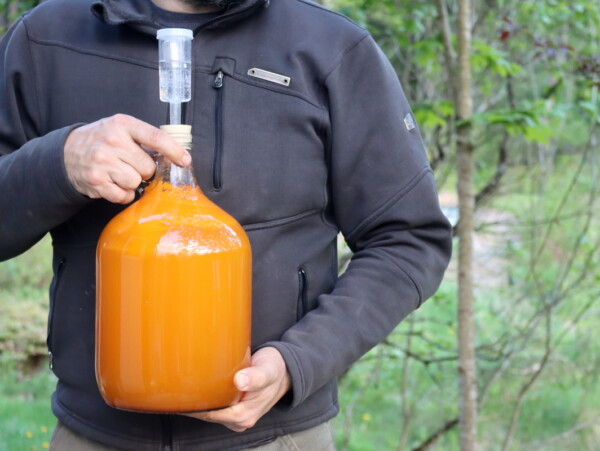


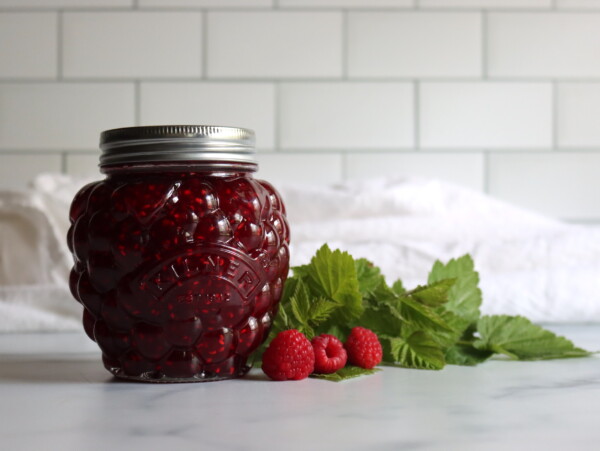







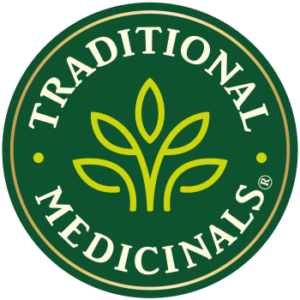


Can the lime solution be used several times with new batches of eggs? If so, how many times?
I personally would recommend using new lime solution each time just to be safe.
This was very interesting, I liked this story.
Thank you. We’re so glad you enjoyed it.
Back in the day when |I farmed I froze the fresh eggs. Broke them into margarine tubs, marked 1, 2, or 3 depending on number of eggs in each one. They work fine for cooking and baking and I always had lots so could bake all year long.
Ashley, our ducks lay lovely eggs for us daily, but, they lay them in the creek….which is kind of like washing the eggs. So I’m assuming this lime process would not work in my case, correct? If not, are we still safe to eat and use the eggs if they are refrigerated once we harvest them out of the water (which is quite cool all the time in our neck of the woods here in the foothills of NC).
Yes, that would be the same as washing. They are definitely fine to eat once you harvest them out of the water but I would store them in the fridge since the bloom will have been washed off.
You can freeze them…I baked with duck eggs for years…makers the best cakes
I wonder where pickling lime can be purchased? I’m in Canada. I’ve never seen this in a grocery or hardware store, and on Amazon the bag pictured is $30!
It can also sometimes be called hydrated lime or slacked lime. It should be in the section with the other canning and preserving supplies.
Dear Laura in Ontario,
I found this place (link below) and emailed them March 31, 2022 asking when they will have pickling lime (calcium hydroxide) back in stock. They emailed me back April 1 and below is their reply along with the link to this product on their site. To date it’s not in stock but I recommend checking with them often to see when it will be back in stock. According to their message below, it shouldn’t be long. As to shipping cost and where they ship you would have to contact them. Hope this helps!
https://www.azurestandard.com/shop/search/pickling%20lime
Thank you for contacting Azure Standard. I have checked on the product information on the Cal Lime, Calcium Hydroxide, Food Grade and it appears that this is marked as a “short-term” outage. This typically means that we are actively working with our vendor to get this product back in stock.
Unfortunately, at this time we do not have an arrival date, but we will update our website as soon as that information becomes available.
My sister-in-law has chickens and gives me eggs but they’ve always been refrigerated before giving to me. She forgets to not refrigerate them. Anyway., WHY can’t one bring refrigerated fresh eggs to room temp, then preserve them? What is the deal with them being refrigerated?
Thank you
Carrie
Refrigeration has the potential to kill the embryo inside and start deterioration before they’re put into the lime water. That’s theoretical, and honestly, they do tend to get cold outside in the coop in the early spring anyway.
The main thing is they absolutely must be unwashed and very fresh. I think it’s possible it might work if they’re refrigerated for a day or two, but if they’ve been in here fridge all week or longer then no. (I don’t know, I’ve never tried it, so that’s just my best guess…at your own risk and all). Either way, just be 100% sure she’s not wetting them or washing them.
Sorry that I can’t be more helpful here, but I’ve never worked with refrigerated eggs here and every guide I’ve found says not to do it. Why? I can’t say for sure.
I think when the eggs are refrigerated it can cause condensation which can remove the bloom.
Thank you for your article. I will be staying a bucket this week.
Up to how many days old can an un-refrigerated unwashed egg be to still preserve it in lime water? I’m hoping I can get some from my sister-in-law but she does not live in the same town as me so the eggs could be 2-3 days old before I get them, that’s why I ask. Thank you again.
It is recommended to only use eggs that have been collected that day.
Makes sense! Thank you.
Hi Ashley,
I used the lime preservation method last year, from April through September 2021 whenever I had extra eggs. I started to use them in February 2022. I have found they taste good and are fine for scrambled eggs or baking. But they are not good for frying, which is fine. The Yolks are often broken and sticking to the shell when I cracked into the bowl and the whites are very runny. I wonder if you have experienced this? I wonder if this is normal or if something has gone slightly wrong.
Also, my half gallon glass jar has a ring of lime crust around the rim where the water level was. I can’t seem to soak it off or scrape it off. Any solutions to this problem?
Thanks for all your guidance in so many fields. Jen
I have not heard of this issue with the yolks sticking to the shell. I do think it’s pretty common for the yolks to break more easily though. Have you tried vinegar for the crust around the rim?
There has been a few comments on here about how long the eggs keep under different conditions and under different levels of soiling. I have only started my first batch of eggs using this method today, but I have been keeping chooks for 20 something years and I have some useful observations. I often keep eggs for hatching and sometimes a carton gets misplaced . I might not find this carton for 2 – 3 years. These eggs seldom go bad because I’m conscious to save only clean eggs for setting. They do however completely dehydrate so that there is only a yellow amber like hard substance occupying about 5 – 10% of the shell. I think the lesson here is that the bloom will protect the egg from bacteria and going fowl, but it does not protect it from dehydration. Submersing an egg in water will protect from dehydration, but it needs additional protection from bacteria. The lime produces a very alkaline environment which cannot support bacterial growth, so as long as there are no bacteria inside the shell, in theory the eggs shouldn’t go bad, but the structure of the egg white and yolk will slowly deteriorate over time, and it is this factor which determines how degraded are you willing to eat an egg, even if it’s safe from bacteria…
I saw this site a bit late and just learned I’m supposed to use clean eggs gathered that day. I did a batch in mid November that had sat out for up to a week or so.
I’ve been eating them but the yolk is really runny. My wife said they smell like fish or seaweed but I didn’t notice anything. Am I to assume the runny yolk is because they weren’t put in solution right away? These are also Amish eggs so I don’t know how old they are.
If you are storing eggs in limewater you do not want to wash them before putting them in the solution. You need to be sure that they are very clean though and that they are put in the solution the same day that they are collected. I personally would not put eggs in limewater that I hadn’t collected myself to ensure that they were handled properly. If the yolks are runny and there is an off smell, I would say that they are probably bad.
I did this all summer long and finally used an egg today! However… the egg was terribly foul smelling. What did I do wrong?? I haven’t cracked another yet.
Did you use fresh, clean, unwashed eggs?
Yes, straight from the coop and unwashed 🙁
I would go ahead and crack some others and just check them. It could have been that one egg.
can you use the pickled lime on chicken eggs already refrigerated a couple days?
It is recommended that you only use eggs that have been gathered the same day. If they are several days old, I would not suggest it even if they have been in the refrigerator.
Do you know if you can seal the jar with a metal lid?
I believe that the lime can react to some metals so it would probably be safer to use plastic or glass.
I asked a question about already putting dirty eggs in the water 24 hours ago not knowing they could not be and that they needed to be fresh that day. But then was looking around and found this site. Now what can I do with the eggs?
Forgot to request an email comment n quefstion.
You could do some more research to find out but I would probably toss them. It’s likely that the bacteria from the dirty eggs could have penetrated the shell by this point.
The only pickle crisp granules I could find were Calcium Chloride. Will that work the same or no?
I don’t know the answer to that. Everything I have read shows to use the Calcium Hydroxide. If you can’t find it locally, you can probably order some online.
I live in texas and my house stays around 70°. Unfortunately i don’t have a root cellar or basement. I want to store them in lime water but I’m not sure where to keep them? Any suggestions?
You could try keeping them in the limewater at room temperature. They will most likely keep longer than if they were not in the limewater but not as long as in the limewater and cooler temperatures. You could do a little experiment and see how long they would last.
Silly question, but : I wonder where our ancestors got the pickling lime from?? Any thoughts?
I found this article that talks a little more about the history. https://vintagerecipesandcookery.com/preserve-eggs-slaked-lime-water-glass/
I have done this and it does work 🙂
Does anyone know if after you have used up all the eggs in your pickling lime H20 solution if you can reuse or refresh the pickling lime water for the next fresh batch of eggs??
That’s a good question. I don’t really know that answer but my suggestion would be to start with fresh solution each time just to be safe.
That was going to be my question too. I wonder if we did a test batch and see how long it takes till eggs start to float in the reused water solution?
I had about a dozen eggs in lime water for about 2 weeks; then I broke an egg in the mixture, so I removed the eggs and rinsed them lightly, then made another lime solution and put them back. Is that ok, or should I not have rinsed them? Should I just use them up? I wasn’t sure if the bloom and the lime water had already done it’s job and sealed the egg.
I am not really sure. I would probably use them up to be safe but you could leave 1 or 2 in there and just see how they do.
Can you use fresh eggs that are a few days old? I started saving clean eggs but the pickling lime that was supposed to come on Thursday, didn’t come until the next Monday. So do the eggs need to be that day fresh or is a few days on the counter okay?
The recommendation is to use eggs that are pulled from the nesting boxes that day. I would just use the eggs that you have been saving and start preserving those that are laid after you receive the pickling lime.
Just curious, how long does it take an egg to dry after it’s layed and does the straw in their nests help with this? I really enjoyed learning how to preserve them.
It takes just a few minutes for the bloom to dry on the egg. I am not sure how much the straw would help with this other than maybe allowing for more airflow around the egg.
I AM GETTING READY. ORDER EGGS TODAY BOUGHT GOOD WATER. AND PICK UP LIME TOMORROW. I HATE TO RUN OUT OF FRESH EGGS. THANK YOU FOR YOUR INFORMATION.
You’re very welcome.